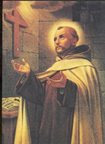The Carmelites take their name from their place of origin—the biblical mountain of Carmel. Revered as one of the sacred places in Palestine, Mt. Carmel has also been associated with their great Old Testament prophets, Elijah and Elisha.
During the time of the crusades, a group of men decided to settle on Mount Carmel. They made the prophet Elijah as their inspiration and model. Thus, the prophet became the Spiritual Father of the Carmelites.
From the very beginning, the hermits paid honour to Mary, the Mother of God. Hence, the first chapel of the Carmelites was dedicated to the honour of the Blessed Virgin Mary. Moreover, they referred to themselves as the Brothers of Our Lady of Mount Carmel.
By 1210, St. Albert the Patriarch of Jerusalem gave the Carmelites a rule. This would serve them as their guide as they increased in numbers.
However, the growing conflict in the Holy Land, against the Saracens, forced the early Carmelites to move out of Palestine. They migrated to Western Europe where they adopted the lifestyle of the growing urban civilization thus, embracing a mendicant way of life.
As mendicants they now engaged themselves in various apostolic services to the Church. They went in the towns and universities of Europe responding to the needs of the Church at that time.
All this time, the Carmelites faithfully held the strong contemplative spirit as an essential part of their identity.
The Middle Ages maybe considered as a challenging era in the life of the Church. Several historical events brought about the decline of the life of the Religious Orders, including that the Carmelites. Moreover, it also during this time that of the Carmelites decided to mitigate their rule of life.
The mitigation of the Rule brought about several reactions from the members of the Order. One of them was the call for the Order's reform. There were many movements for reform; one of them was initiated by St. Teresa of Jesus in Avila in Spain. This would be one of the most successful and enduring reforms within the Church.
Together with St. John of the Cross, St. Teresa of Jesus sought for the restoration of the ancient prophetic spirit of the first Carmelites in the midst of a changing world. Just like the hermits of Mount Carmel they provided the environment where women and men could come to experience God's loving and healing presence in a world that was torn by strife and division.
The Filipino Discalced Carmelites of the third millennium are faced with the same challenge. After the footsteps of the Holy Parents, they are called to give witness to the prophetic spirit of the first Carmelites. The Teresian Carmelites today are challenged to live their great tradition of contemplative prayer and apostolic service to the Church. Just like the first hermits, today's Carmelites are called to become a sign of God's presence among His people and of His loving concern for them.
The Carmelite Sisters from Hue, Vietnam arrived in the Philippines in 1925. This was made possible upon the invitation of the Bishop Jaro, Msgr. James McCloskey. However, it was only in 1947 that the Carmelite friars would find their way to the Philippines.
The first group of Discalced Carmelite friars came from the Province of the Immaculate Heart of Mary, in Washington. They came to the country upon the invitation of the Bishop of Lipa as their area of mission.
By the 1950's, Carmelite friars from the Anglo-Irish province came to help the American friars in the Infanta mission. By mid 50's the Irish friars started the Carmelite mission in Jaro, Iloilo. At about the same time, the Irish friars began the Carmelite foundation in Quezon City. They constructed a large Church in Broadway, New Manila Quezon City, now popularly known as the National Shrine of Our Lady of Mount Carmel.
Meanwhile, the Infanta mission was progressing. On April 25, 1959, Infanta was elevated to a Prelature—the first step towards becoming a full-fledged diocese. Three years after, Fr. Patrick Shanley was consecrated as the first Bishop the Prelature.
The first fruit of the Carmelite mission came in the persons of three Filipinos who were ordained to the priesthood: Fathers Anselmo Cañonero, Bernard Ybiernas, and Julio Xavier Labayen. Fr. Labayen would later succeed Msgr. Patrick Shanley as Bishop of the Prelature of Infanta.
The Teresian Carmelites both from the Washington and the Anglo-Irish Provinces have began to take root in the Philippines. In 1977, The Filipino Teresian Carmelite Commissariat was established. This was a positive step as the Filipino Carmelites look forward to the creation of a Filipino Teresian Carmelite Province in the near future.
A Brief History of Discalced Carmelites
Subscribe to:
Posts (Atom)


